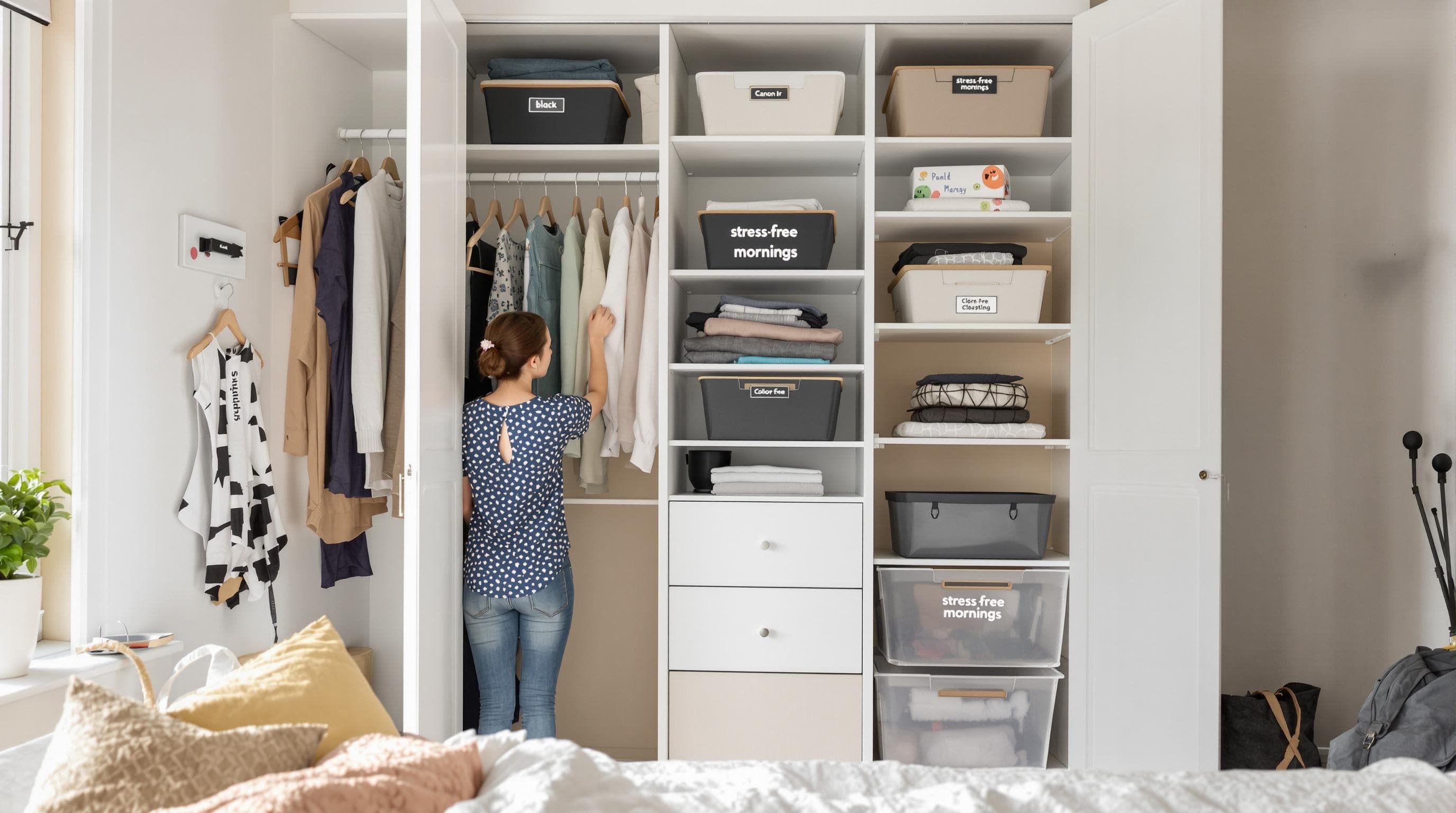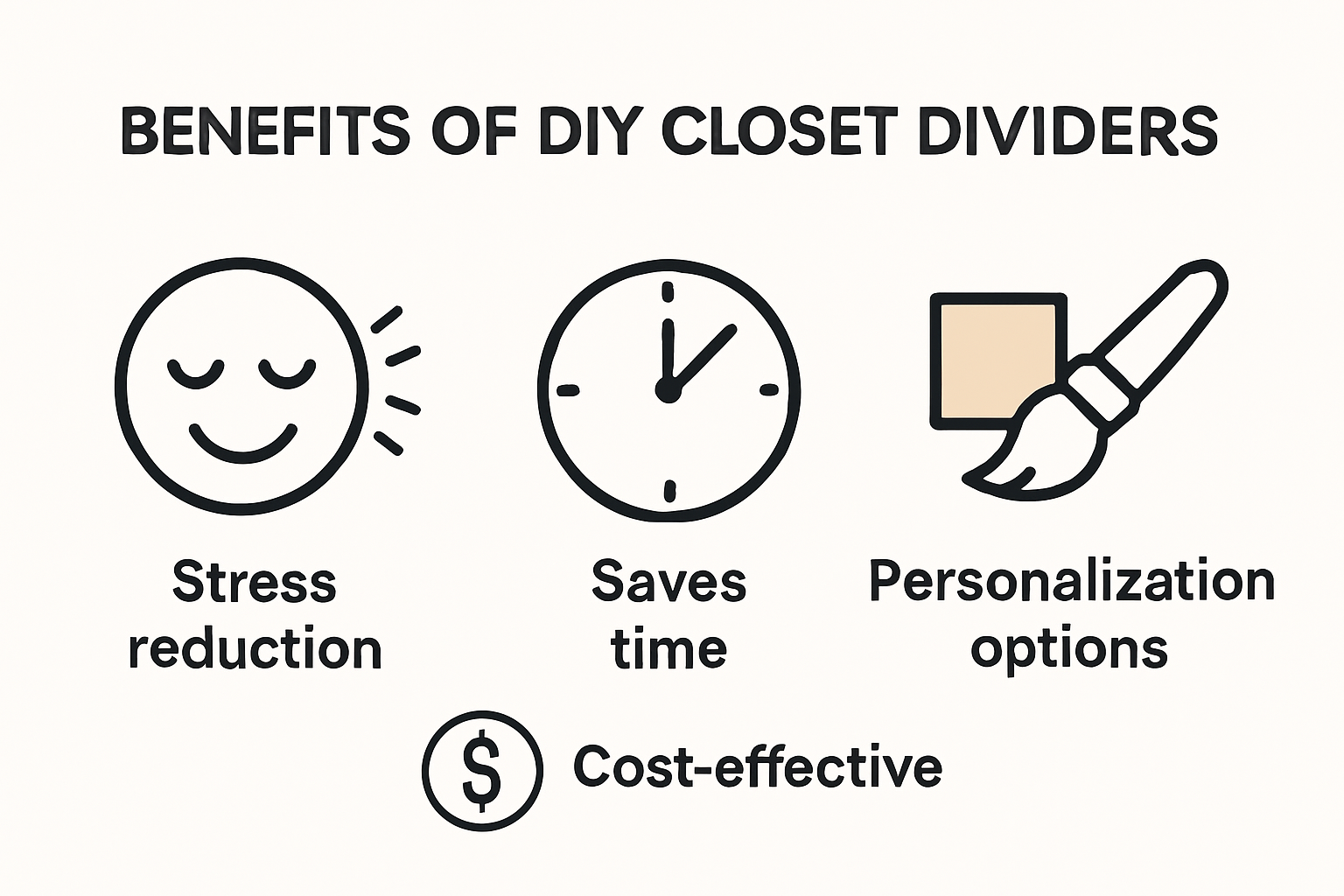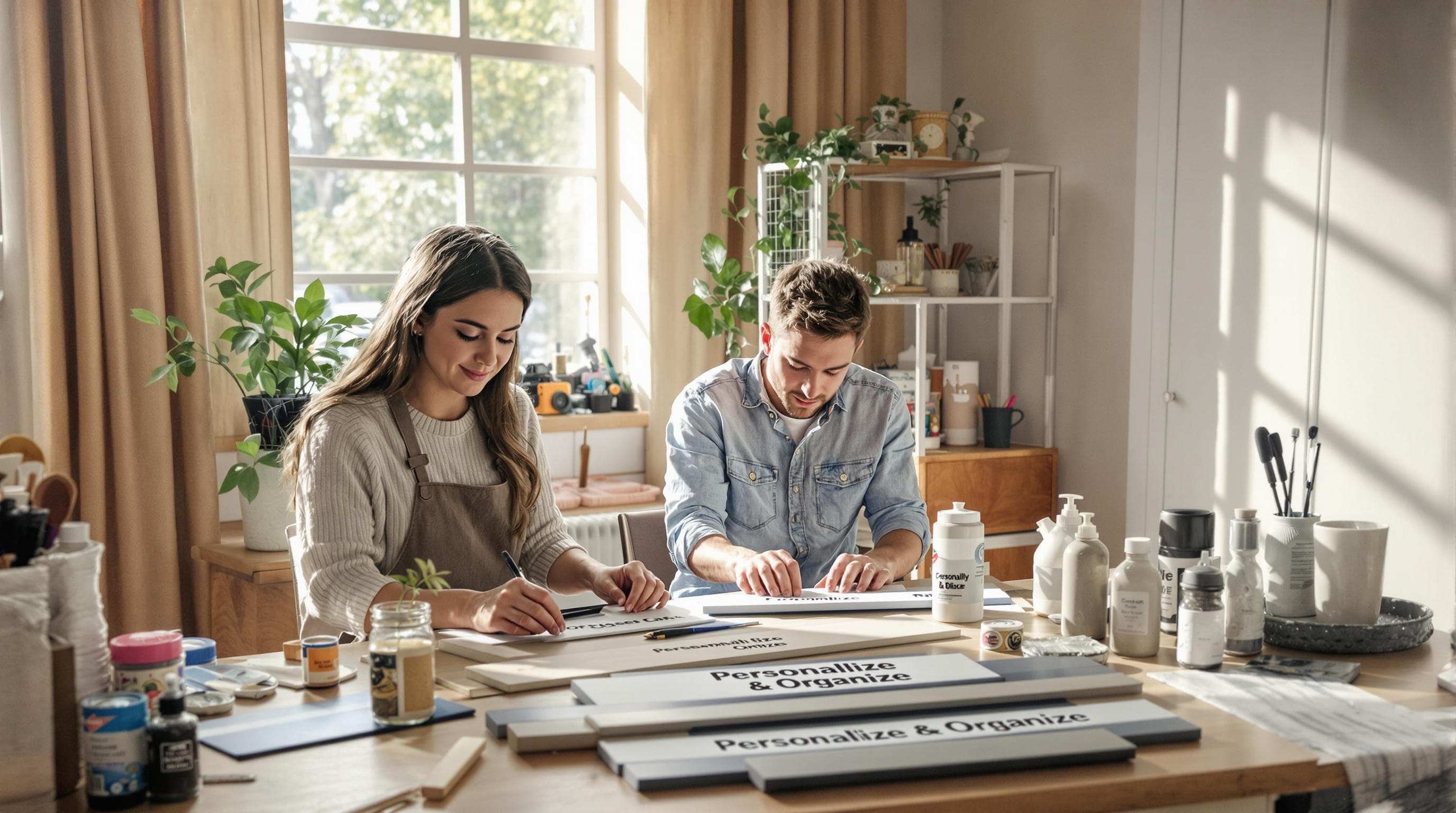

Closet clutter might seem harmless, yet it quietly chips away at your peace of mind and eats up precious time each day. Think about this. A well-organized closet can actually lower stress levels and help you reclaim up to 30 minutes every morning. Most people focus on fancy storage gadgets or pricey systems, but what if the real transformation comes from a handful of creative DIY dividers you make yourself?
Table of Contents
- Why Use Diy Closet Dividers At Home
- Creative Materials And Quick Design Ideas
- Step-By-Step Guide To Making Closet Dividers
- Tips To Personalize And Maintain Closet Organization
Quick Summary
| Takeaway | Explanation |
|---|---|
| Mental Health and Organization | A well-structured closet using DIY dividers can significantly reduce daily stress and improve overall mental clarity, promoting a calm environment. |
| Time-Saving Benefits | Strategic organization with DIY closet dividers helps locate items quickly, saving precious time during hectic morning routines. |
| Personalization and Cost-Effectiveness | DIY closet dividers allow for complete personalization to fit specific storage needs and aesthetics, offering a budget-friendly solution compared to commercial systems. |
| Seasonal Rotation and Maintenance | Regularly assess and rotate clothing by season, maintaining your closet organization system to adapt to changing needs and prevent clutter. |
| Technology and Tracking | Integrate digital inventory methods and tracking features to maintain organization and manage clothing maintenance effectively. |

Why Use DIY Closet Dividers at Home
Closet organization is more than just arranging items neatly. It’s about creating a functional space that reduces daily stress and improves your overall quality of life. DIY closet dividers offer a practical and personalized solution to transform chaotic spaces into efficient storage systems.
Mental Health and Organization
Organizing your closet isn’t just about aesthetics. Research reveals that a well-structured closet can significantly reduce daily stress. When you create systematic spaces using DIY closet dividers, you’re not just sorting clothes. You’re creating a calm environment that promotes mental clarity and reduces anxiety.
According to psychological studies, an organized space directly impacts your mental well-being. Cluttered environments contribute to increased stress levels, while neat, structured spaces help you feel more in control. DIY closet dividers enable you to create visual boundaries that make your storage intuitive and accessible.
Time-Saving Benefits
Time is a precious resource, and DIY closet dividers can help you reclaim it. By creating designated spaces for different clothing categories, accessories, and personal items, you eliminate the daily frustration of searching for misplaced items. Storage experts suggest that proper organization can save significant time during morning routines.
Think about those hectic mornings when you’re rushing to get dressed. With strategically placed DIY closet dividers, you can quickly locate exactly what you need. Color-coded sections, separated compartments for work and casual wear, and clear accessory zones streamline your preparation process.
Personalization and Cost-Effectiveness
Commercial closet organization systems can be expensive. DIY closet dividers offer a budget-friendly alternative that allows for complete personalization. You can design dividers that match your specific storage needs, aesthetic preferences, and available space. Whether you’re working with a walk-in closet or a compact wardrobe, custom dividers adapt to your unique requirements.
By creating your own closet dividers, you’re not just saving money. You’re also engaging in a creative project that provides a sense of accomplishment. Materials like cardboard, wood, fabric, and even repurposed items can be transformed into effective storage solutions. Check out our guide on creative storage solutions for more inspiration on personalizing your space.
In 2025, home organization is about smart, adaptable solutions that reflect individual lifestyles. DIY closet dividers represent more than a storage technique. They’re a strategic approach to managing your personal space, reducing stress, saving time, and expressing your unique organizational style.
Creative Materials and Quick Design Ideas
Transforming your closet doesn’t require expensive solutions or professional help. With creativity and some basic materials, you can design functional and stylish DIY closet dividers that reflect your personal organizational style.
Unexpected Materials for Closet Dividers
Traditional organization tools are just the beginning. Better Homes & Gardens highlights innovative approaches to closet organization using unconventional materials. PVC pipes, for instance, can be transformed into excellent shoe storage systems. Wooden dowels, cardboard, and even repurposed picture frames can become versatile dividers that categorize and separate your clothing.
Consider materials like foam board, which is lightweight and easy to cut. Fabric-covered cardboard panels offer a soft, aesthetic touch while creating clear boundaries in your closet. Wooden rulers or paint stirrers can be painted and decorated to create color-coded section markers. The key is thinking beyond traditional storage solutions and seeing potential in everyday items.
Here is a table to help you compare different material options and their pros and cons for DIY closet dividers:
| Material | Key Features | Pros | Cons |
|---|---|---|---|
| Cardboard | Lightweight, easy to cut | Affordable, widely available | Less durable |
| Foam Board | Lightweight, sturdy | Easy to work with, customizable | Not water-resistant |
| Plywood/Wooden Dowels | Rigid, long-lasting | Durable, can be painted/finished | Requires tools, heavier |
| PVC Pipe | Hollow, sturdy | Easy to clean, good for shoes | Cutting tools needed |
| Picture Frames | Pre-made structure | Can be repurposed, decorative | May need reinforcement |
| Fabric-covered Cardboard | Soft surface, flexible | Aesthetic, protects clothing | More time-consuming |
| Paint Stirrers/Rulers | Slim, wood | Inexpensive, easy to label/color | Small size limits use |
Design Techniques for Maximum Efficiency
Twig & Thistle recommends several design strategies to maximize your DIY closet dividers. One approach involves creating modular dividers that can be easily rearranged. By using interlocking design principles, you can build dividers that adapt to changing wardrobe needs.
Color coding is another powerful technique. Paint your dividers in different colors to represent clothing categories like work wear, casual attire, or seasonal clothing. Our space-saving storage guide offers additional insights into making the most of limited closet space.
Personalized Labeling and Tracking
Uncommon Designs introduces an innovative concept of chalkboard dividers. By painting wooden door hangers with chalkboard paint, you can create interactive closet dividers that help plan weekly outfits. Write outfit combinations, track laundry days, or note items that need replacement.
Additional labeling techniques include using adhesive vinyl, stencils, or removable labels. These allow you to categorize sections precisely while maintaining flexibility. Magnetic labels offer another dynamic solution, enabling easy reorganization as your wardrobe evolves.
In 2025, DIY closet dividers are more than storage tools. They’re personal organization systems that blend functionality with creativity. By selecting the right materials and employing smart design techniques, you can transform your closet into an efficient, personalized space that simplifies your daily routine.
Step-by-Step Guide to Making Closet Dividers
Creating DIY closet dividers is a straightforward process that transforms your storage space with minimal effort and maximum creativity. Whether you’re a seasoned DIY enthusiast or a beginner, this comprehensive guide will walk you through the essential steps to craft personalized closet dividers.

Gathering Materials and Tools
Popular Mechanics emphasizes the importance of preparation before starting any DIY project. For basic closet dividers, you’ll need essential materials like cardboard, foam board, or plywood. Additional tools include:
- Measuring tape
- Sharp utility knife
- Ruler or straight edge
- Pencil
- Sandpaper
- Paint or decorative paper (optional)
- Adhesive or mounting brackets
Measurement is crucial. Take precise measurements of your closet space, accounting for width, height, and existing shelving. Our storage solutions guide provides additional tips for maximizing your organizational potential.
Construction Techniques
The Home Depot recommends several construction approaches depending on your chosen material. For cardboard dividers, follow these steps:
- Measure and mark your cutting lines carefully
- Use a sharp utility knife and straight edge for clean cuts
- Create interlocking designs for stability
- Sand edges for a smooth finish
- Optional: Cover with decorative paper or paint
For wooden dividers, additional steps include:
- Cutting wood to precise measurements
- Sanding surfaces
- Applying wood finish or paint
- Installing mounting brackets
Below is a table summarizing the step-by-step process for making DIY closet dividers. This helps to clarify each stage at a glance and shows which steps are specific to certain materials.
| Step | Cardboard/Foam Board | Wood/Plywood | Tools Needed |
|---|---|---|---|
| Measure and mark cutting lines | Yes | Yes | Measuring tape, pencil |
| Cut material to size | Yes | Yes | Utility knife (cardboard), saw (wood) |
| Sand edges for smoothness | Optional | Yes | Sandpaper |
| Create interlocking/stabilizing design | Yes | Optional | Ruler, utility knife/saw |
| Decorate (paint, cover, finish) | Optional | Optional | Paint, decorative paper |
| Install mounting (adhesive/bracket) | Adhesive, tape | Brackets, anchors | Double-sided tape, brackets |
Customization and Installation
Instructables highlights the importance of customization. Consider these advanced techniques:
- Create modular dividers that can be repositioned
- Use magnetic strips for easy attachment
- Design color-coded sections
- Add labels for specific clothing categories
- Incorporate adjustable elements
When installing, ensure dividers are securely mounted. Use appropriate adhesives or brackets based on your material. For lightweight materials like cardboard, strong double-sided tape works well. Wooden dividers might require wall anchors or mounting brackets.
Remember that DIY closet dividers are about personalization. Don’t be afraid to experiment with designs, materials, and configurations. Your goal is creating a system that makes your daily routine more efficient and enjoyable. Start simple, learn from each project, and gradually develop more complex organizational solutions that perfectly suit your lifestyle.
Tips to Personalize and Maintain Closet Organization
Personalizing and maintaining your DIY closet dividers goes beyond initial creation. It’s about developing a sustainable system that evolves with your lifestyle and keeps your space functional and inspiring.
Seasonal Rotation and Wardrobe Management
Closet organization is a dynamic process. Marie Kondo’s organizational philosophy emphasizes the importance of regular assessment and intentional keeping. Implement a seasonal rotation strategy where you reassess your closet dividers every three to four months.
Start by categorizing clothing by season and purpose. Create dedicated sections for winter wear, summer attire, work clothes, and casual outfits. Our comprehensive storage guide offers additional insights into maximizing your closet’s potential. Use removable labels or color-coded markers to distinguish these sections, allowing for easy transition between seasons.
Technology and Tracking
Modern closet organization integrates smart tracking methods. Consider creating a digital inventory of your wardrobe using smartphone apps that help you catalog clothing items. Take photos of each section after organizing, creating a visual reference that helps maintain your system.
Use QR codes or simple tags on your DIY dividers to track clothing maintenance. Note dry cleaning requirements, repair needs, or donation considerations. This approach transforms your closet dividers from mere storage solutions into comprehensive wardrobe management tools.
Maintenance and Continuous Improvement
Regular maintenance prevents organizational systems from becoming cluttered. Schedule monthly review sessions where you:
- Remove items no longer fitting your lifestyle
- Repair or replace worn dividers
- Clean and dust your closet organization system
- Reassess your current categorization strategy
Consider the emotional connection to your clothing. Not every item needs to be kept forever. Create a donation section in your closet dividers for items that no longer serve you. This practice keeps your space fresh and meaningful.
Personalization is an ongoing journey. Your DIY closet dividers should reflect your current lifestyle, personal growth, and aesthetic preferences. Don’t be afraid to experiment, modify, and redesign your system as your needs change. What works perfectly today might require adjustment in six months.
In 2025, closet organization is about creating a personal ecosystem that supports your daily routine. By treating your DIY closet dividers as a living, breathing system rather than a static storage solution, you’ll develop an organizational approach that truly enhances your life.
Frequently Asked Questions
What are DIY closet dividers?
DIY closet dividers are organizational tools that help separate and categorize items in your closet, making it easier to find and manage clothing and accessories. They can be made from various materials such as cardboard, wood, or repurposed items.
How can DIY closet dividers improve mental health?
A well-organized closet can reduce daily stress by providing a calm and decluttered environment. By using DIY closet dividers, you create systematic spaces that enhance mental clarity and control over your personal space.
What materials are best for making DIY closet dividers?
Some effective materials for DIY closet dividers include cardboard, foam board, plywood, PVC pipes, and fabric-covered panels. Each material has its pros and cons, including durability, ease of cutting, and aesthetic appeal.
How do I maintain my DIY closet organization?
To maintain your DIY closet organization, regularly assess and rotate your clothing based on seasons, utilize technology for tracking items, and schedule monthly reviews to remove non-essential items and clean your dividers. Regular maintenance ensures a clutter-free and efficient organizational system.
Upgrade Your Closet Organization with Functional Style
If you are ready to turn the DIY spirit from this article into a high-impact daily routine, discover the difference that real storage solutions can make. Struggling with clutter and wasting time every morning searching for clothes often leads to unnecessary stress. With DIY closet dividers, you get creativity and customization, but combining that with the right storage products can truly transform your bedroom into a haven of order and calm. Check out the latest range of closet and bedroom storage essentials on our Bedroom Storage page to build on the foundation of your new system and maintain a beautifully organized space all year.

Why wait to enjoy a stress-free start every morning? Shop now at https://blushbees.us to explore everything from durable storage boxes to stylish baskets and special offers made just for you. Take control of your space today and experience just how easy organization can be with the right support.
Recommended
- Top Closet Storage Ideas for Stylish Homes in 2025 – BLUSHBEES USA
- Closet Organization Tips 2025: Stylish & Easy Solutions – BLUSHBEES USA
- Bedroom Storage tips the Pros use – BLUSHBEES USA
- 10 Home Organization Tips for a More Tidy and Efficient Living Space – BLUSHBEES USA
- Layering Window Treatments: Modern UK Ideas for 2025 Homes | Shutter World
- How to Pack a Storage Unit: Expert Guide for Every Need 2025 - STOMO Mobile Storage and MOVEMO Moving Service



